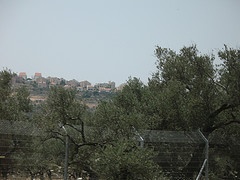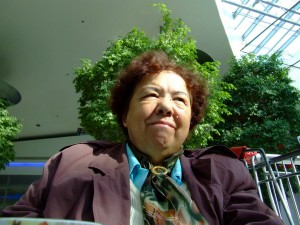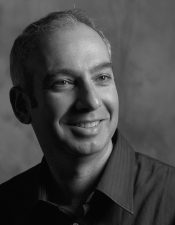 We are accustomed to writing about art and architecture that addresses environmental and social problems in the Middle East, but nothing as interesting as Larissa Sansour’s Nation Estate has crossed our desk before.
We are accustomed to writing about art and architecture that addresses environmental and social problems in the Middle East, but nothing as interesting as Larissa Sansour’s Nation Estate has crossed our desk before.
Conceived in 2011 when Palestinian authorities appealed to the United Nations for nationhood status, the sci-fi short film and photographic series takes a critical look at the impossibility of creating an actual physical space where the scattered Palestinian population can reunite. Sansour proposes, with a lot of tongue and even more cheek, an enormous (and obviously fictional) high rise.
 You might be wondering why this project would appear on Green Prophet – as controversial and political as the discussion surrounding anything to do with Israeli and Palestinian relations can be, and that would be valid since the artist makes no direct allusions to environmental issues.
You might be wondering why this project would appear on Green Prophet – as controversial and political as the discussion surrounding anything to do with Israeli and Palestinian relations can be, and that would be valid since the artist makes no direct allusions to environmental issues.
However, the issue of land and population growth are as environmentally relevant as they are political.
Israel’s territory is comprised of 20,330 sq km of land, according to the CIA Factbook, designated for a population of 7,590,758. [Approximately 325,500 Israeli settlers live in the West Bank (2011); approximately 18,700 Israeli settlers live in the Golan Heights (2011); approximately 186,929 Israeli settlers live in East Jerusalem (2010)]
The West Bank land area consists of 5,640 sq km. This includes the “West Bank, Latrun Salient, and the northwest quarter of the Dead Sea, but excludes Mt. Scopus; East Jerusalem and Jerusalem No Man’s Land are also included only as a means of depicting the entire area occupied by Israel in 1967.”
In July, 2012, roughly 2,622,544 Palestinians were living in the West Bank and 1,710,257 in the Gaza Strip. Currently a series of checkpoints separate these spaces and any kind of mobility – whether for medical, family, or employment reasons – is very trying.
 Sansour’s project seems to ask whether anyone sketched out a plan for where the 4,332,801 Palestinians might live should should a so-called “real” Palestine ever come to pass. And if they haven’t, she has a suggestion that casts a questioning eye on the very symbols of nationhood that have arrested the peace process.
Sansour’s project seems to ask whether anyone sketched out a plan for where the 4,332,801 Palestinians might live should should a so-called “real” Palestine ever come to pass. And if they haven’t, she has a suggestion that casts a questioning eye on the very symbols of nationhood that have arrested the peace process.
Palestinians can live “the high life” in Nation Estate – a nation within an enormous high rise building. Each floor represents a particular city:- Bethlehem is on the 12th floor and Jerusalem is on the 4th.
Each floor is then decorated with landmark buildings and symbols, including the Church of the Nativity and Dome of the Rock, to create a sense of identity. And instead of passing through checkpoints, residents need only take an elevator to reach the next “city.”
Science fiction imitates life: by 2050, according to the World Health Organization (WHO), seven out of ten people will live in cities. Many will live in derelict shacks on the outskirts, depending on where they are, while many others will live in dense high-rise apartments not so unlike Sansour’s Nation Estate.
Naturally we don’t think this is the best response to the deadlock between Israeli and Palestinian authorities, but it does express the enormous complexity of the situation that is so often lost in mainstream discourse.
Sansour’s controversial project was nominated for the 2011 Lacoste-sponsored Elysée Prize of Switzerland’s Musée de l’Elysée, although the nomination was retracted since Lacoste did not want to be associated with the work’s political overtones, according to Free Arabs.



